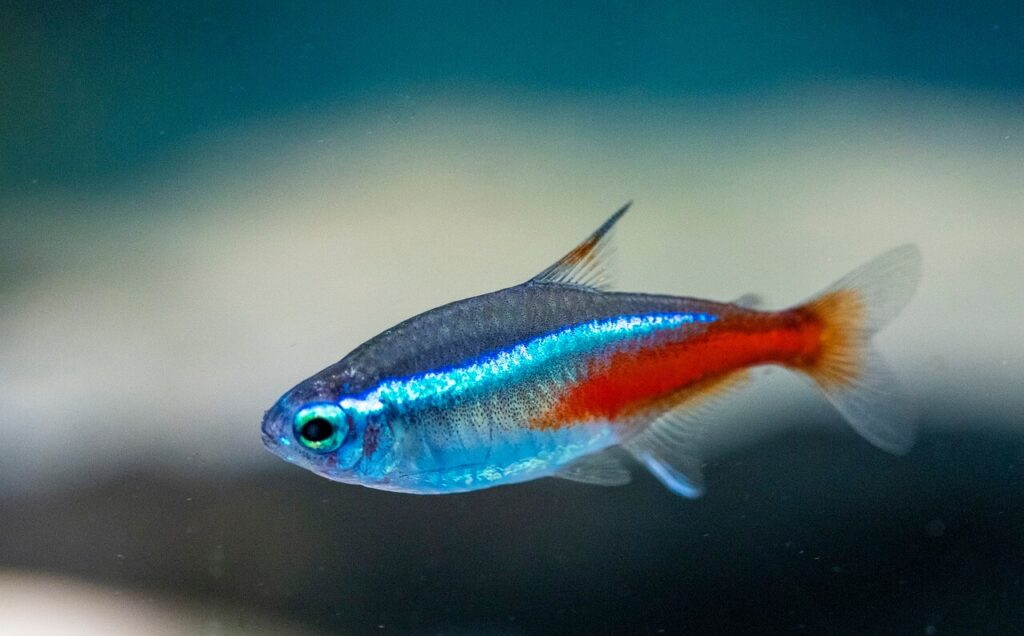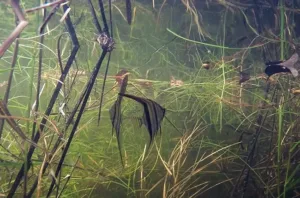Welcome to our comprehensive guide on Neon Tetra feeding tips. Neon Tetras, renowned for their stunning iridescent colors, are a beloved choice among aquarium enthusiasts. To keep these captivating fish at their vibrant best, it’s essential to understand their dietary needs and feeding habits. In this article, we will provide you with expert advice and insights into the art of feeding Neon Tetras, ensuring that your aquatic pets flourish in your aquarium.
Neon Tetras, scientifically known as Paracheirodon innesi, originate from the blackwater streams of South America, where their diet primarily comprises small aquatic insects, worms, and microorganisms. Replicating this diet in a captive setting is vital to their overall health and well-being Neon Tetra feeding.
Feeding Neon Tetras can be a rewarding yet delicate task, as these fish have small mouths and stomachs. We’ll explore the importance of offering small, frequent meals and maintaining a varied diet that includes both animal and plant-based foods. High-quality nutrition plays a pivotal role in enhancing their colors and vitality.
Additionally, we will delve into the specific foods suitable for Neon Tetras feeding, such as flakes, freeze-dried foods, live and frozen options, pellets, and micro pellets. We’ll also provide you with a sample feeding schedule to help you establish a routine that aligns with their natural feeding behaviors.
As you embark on your journey to become a Neon Tetra feeding expert, keep in mind the common Neon Tetra feeding mistakes to avoid, including overfeeding and neglecting water quality. By following our expert guidance and insights, you can ensure that your Neon Tetras thrive and flourish in their aquatic habitat. Whether you’re a novice or an experienced aquarist, this guide will equip you with the knowledge needed to provide the best care for these enchanting fish. Stay tuned for valuable tips and tricks that will make your Neon Tetra-keeping experience both enjoyable and successful.
Neon Tetra Diet
Neon Tetras, scientifically known as Paracheirodon innesi, originate from the blackwater streams of South America. In the wild, their diet primarily consists of small aquatic insects, worms, and microorganisms. Replicating this Neon Tetra feeding diet in captivity is essential for their well-being.
Neon Tetra Feeding Tips
Neon Tetras, with their striking iridescent blue and red hues, are a popular choice among aquarium enthusiasts. To keep these tiny marvels healthy and vibrant, it’s crucial to understand their dietary needs. In this article, we will delve into the intricacies of Neon Tetra feeding, offering expert advice and feeding tips to ensure your Neon Tetras thrive. We will also discuss suitable foods for Neon Tetras.
1. Small, Frequent Meals:
Neon Tetras have evolved to feed on small, frequent meals in their natural habitat. To mimic this behavior in your aquarium, it’s advisable to provide them with several small feedings throughout the day. This not only aligns with their biological rhythm but also prevents overeating and the subsequent water quality issues it can cause. By offering smaller portions, you can ensure that each Tetra has an opportunity to consume its share of food.
2. Varied Diet:
In the wild, Neon Tetras are opportunistic feeders, consuming a mix of animal and plant-based foods. To maintain their health and vibrancy, replicate this diverse diet in your aquarium. While they are primarily carnivores, they also consume algae and small aquatic plants. Incorporating both animal and plant-based foods into their diet provides essential nutrients and helps prevent dietary deficiencies. A varied diet can also enhance their natural colors and behaviors.
3. Use High-Quality Food:
Investing in high-quality fish food is crucial when caring for Neon Tetras. Look for products specifically formulated for small tropical fish like Neon Tetras. These foods are designed to meet their nutritional needs, providing a well-balanced combination of proteins, fats, vitamins, and minerals. While it might be tempting to opt for cheaper options, it’s important to remember that the quality of food directly impacts the health and longevity of your Tetras. High-quality food ensures that your Tetras receive the essential nutrients they require for optimal growth and well-being.
4. Observe Feeding Behavior:
Careful observation of your Neon Tetras during feeding time is essential. It can help you identify any issues with their diet or feeding routine. Keep an eye out for any fish that consistently struggle to access food or appear lethargic during feeding. This could be an indication of competition for food, and you may need to adjust your feeding strategy. Ensuring that all your Tetras have access to food is crucial for their overall health. Some Tetras might be more timid than others, so creating a calm and undisturbed feeding environment is essential for their well-being.
5. Dietary Supplements:
In addition to their primary diet, consider using dietary supplements to enhance the health of your Neon Tetras. Vitamin and mineral supplements can be added to their food periodically, ensuring they receive all necessary nutrients. These supplements can promote stronger immune systems and brighter colors. However, it’s important to use supplements sparingly and in accordance with the manufacturer’s recommendations to avoid over-supplementation, which can be detrimental to your Tetras’ health.
6. Live Foods for Optimal Health:
For enthusiasts seeking to optimize the health and vibrancy of their Neon Tetras, live foods such as live brine shrimp, daphnia, and mosquito larvae are exceptional choices. These foods closely resemble their natural diet and can significantly enhance their coloration and vitality. Live foods are rich in essential nutrients and encourage natural hunting behaviors, promoting physical and mental stimulation for your Tetras.

Best Food for Neon Tetras
Now, let’s explore the specific foods suitable for Neon Tetras:
1. Flakes
Neon Tetras readily accept flake foods, making them a convenient choice for most aquarium enthusiasts. Look for high-quality tropical fish flakes that contain a variety of ingredients to provide a well-rounded diet. Flakes are a staple food for Neon Tetras.
2. Freeze-Dried Foods
Freeze-dried options such as brine shrimp, daphnia, and bloodworms are excellent sources of protein. They are a valuable addition to their diet and can be given as occasional treats. Remember to soak freeze-dried foods briefly in aquarium water before feeding to prevent digestive issues.
3. Live and Frozen Foods
For a more natural diet, consider offering live or frozen foods like daphnia, brine shrimp, and mosquito larvae. These options closely resemble what Neon Tetras would consume in the wild. They provide essential nutrients and can enhance their colors.
4. Pellets
Pelleted foods designed for small tropical fish are another suitable choice. These pellets are formulated to sink slowly, allowing Tetras ample time to feed. Pellets often contain a mix of protein and plant matter, ensuring a balanced diet.
5. Micro Pellets
To cater to their small size, micro pellets are available in the market. These tiny pellets are perfect for Neon Tetras and prevent overfeeding, which can lead to water quality issues.
Neon Tetra Feeding Schedule
To maintain the health and vitality of your Neon Tetras, it’s crucial to establish a feeding schedule. Here’s a sample schedule to consider:
| Day | Morning | Noon | Evening |
|---|---|---|---|
| Monday | Tropical Fish Flakes | Freeze-Dried Bloodworms | Micro Pellets |
| Tuesday | Live Daphnia | Tropical Fish Flakes | Pelleted Food |
| Wednesday | Freeze-Dried Brine Shrimp | Tropical Fish Flakes | Frozen Mosquito Larvae |
| Thursday | Tropical Fish Flakes | Freeze-Dried Daphnia | Micro Pellets |
| Friday | Live Brine Shrimp | Tropical Fish Flakes | Pelleted Food |
| Saturday | Freeze-Dried Bloodworms | Tropical Fish Flakes | Frozen Daphnia |
| Sunday | Tropical Fish Flakes | Freeze-Dried Brine Shrimp | Pelleted Food |
Remember that this is just a sample schedule. Adjust the quantities and types of food based on your Tetras’ appetite and individual needs. Regular observation will help you fine-tune their diet.
Common Feeding Mistakes to Avoid
While feeding Neon Tetras, it’s important to steer clear of common mistakes:
1. Overfeeding
Overfeeding can lead to poor water quality due to excess uneaten food. Neon Tetras are small and have modest appetites. Stick to the recommended portion sizes and frequency.
2. Inadequate Variety
Don’t rely solely on one type of food. A lack of dietary variety can result in nutritional deficiencies. Offer a mix of flakes, freeze-dried, live, and frozen foods to ensure a balanced diet.
3. Ignoring Water Quality
High water quality is essential for the health of your Neon Tetras. Uneaten food and waste can lead to ammonia spikes. Use a good filtration system and perform regular water changes to maintain optimal conditions.
4. Feeding in Poor Lighting
Neon Tetras can be shy, and feeding them in bright light can stress them. Feed your Tetras during their most active hours, which are usually dawn and dusk
In conclusion, mastering the art of Neon Tetra feeding is essential for ensuring the health, vibrancy, and longevity of these captivating aquatic wonders. By adhering to the expert tips and guidelines provided in this comprehensive guide, you are well-equipped to create an optimal feeding regimen that mimics their natural habitat and behaviors Neon Tetra feeding.
Remember to offer small, frequent meals, maintain a diverse diet, and invest in high-quality fish food designed specifically for Neon Tetras. The inclusion of live and frozen foods, along with dietary supplements, can further enhance their well-being and coloration.
Our sample feeding schedule Neon Tetra feeding and insights into common feeding mistakes serve as invaluable tools for both novice and experienced aquarists. By paying attention to your Tetras’ behavior and adjusting their feeding routine as needed, you can ensure that each Tetra gets its fair share of nourishment.
Additionally, don’t overlook the significance of water quality in maintaining a thriving aquarium ecosystem. Regular water changes and proper filtration are essential for providing a clean and healthy environment for your Tetras to thrive.
With our expert guidance Neon Tetra feeding, you can embark on a rewarding journey as a Neon Tetra enthusiast, cultivating a vibrant and harmonious underwater world within your aquarium. These stunning fish are known for their beauty and grace, and with your care and attention, they will continue to captivate and delight both beginners and seasoned aquarists alike.
Stay committed to the principles of optimal Neon Tetra feeding, and your aquatic companions will reward you with their dazzling colors and lively presence for years to come. Thank you for choosing us as your source of information on Neon Tetra care, and we hope this guide has been a valuable resource in your aquarium-keeping endeavors.











